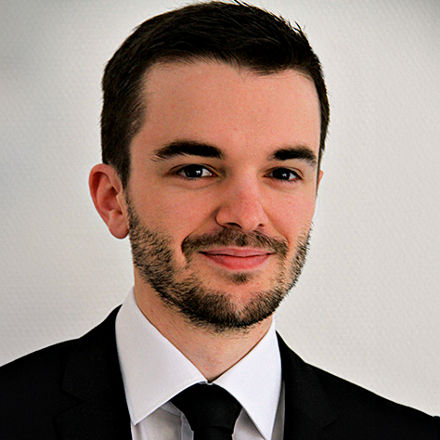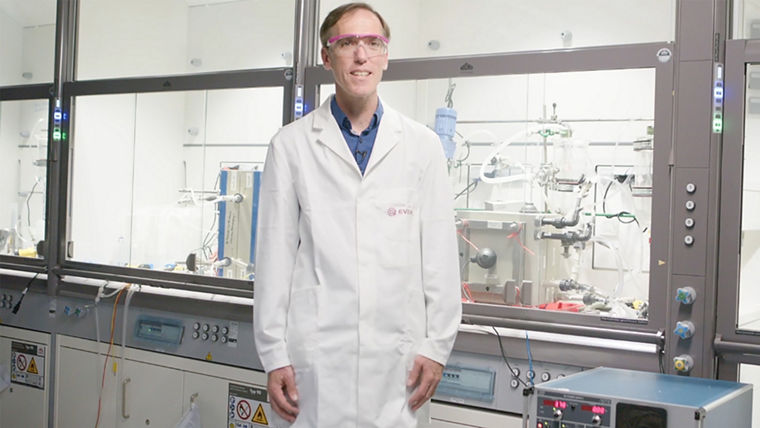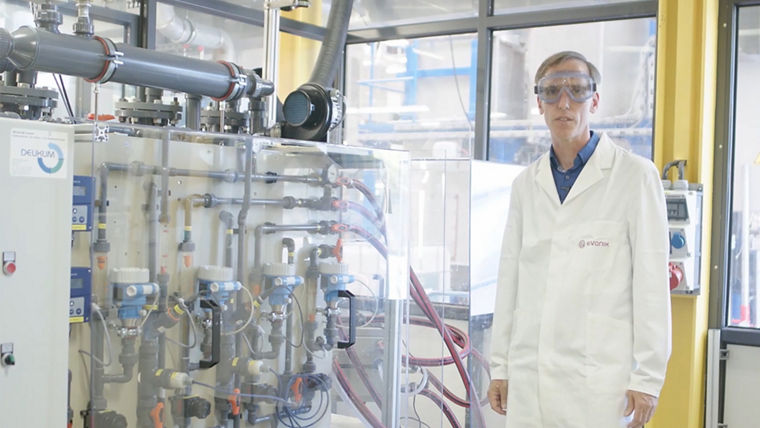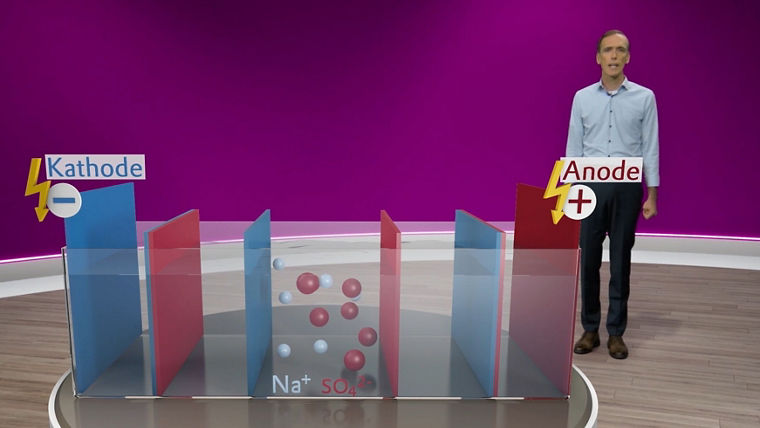At first glance, the white room in the Wolfgang Industrial Park in Hanau hardly differs from other laboratories at Evonik: In the middle are long tables with small centrifugal pumps, and on the sides are fume hoods where men and women in white coats are working with test tubes and Erlenmeyer flasks.
However, if you take a closer look, you will recognize objects that are rather atypical for laboratories: silvery-gray rectangular devices, some barely larger than a smartphone, some as big as a desktop computer. The devices consist of two metal plates connected to cables. A liquid is fed into the gaps through thin lines. Other liquids flow out again on the other side.
“These are caustic soda and sulfuric acid, which we have extracted here in our electrodialysis cell,” explains Patrik Stenner, who heads the Electrochemical Processes & Products platform. Together with around 20 employees at the Evonik locations in Hanau and Shanghai, China, he is researching how chemistry can be powered by electricity.
“The technology enables us to make processes and products much greener,” says Stenner with enthusiasm. “With the help of electricity, we can keep raw materials in circulation and thus save resources.”


A new era in electrochemistry
Electrochemistry is experiencing a renaissance. Researchers around the world are working on reactors that are powered by electricity instead of gas, coal or oil. The focus is now on plasma chemistry and electrolytic processes, in which electrons are used as a raw material. In the future, both basic chemicals and specialty products could be produced in large quantities using electricity from renewable sources—thus helping to reduce greenhouse gas emissions.
Many of the procedures are well known. The foundations for this were laid almost 250 years ago. Until the 20th century, more and more new processes were being developed to manufacture products electrochemically.
Some processes have become well established in industry—for example electroplating, in which surfaces are electrified to coat them with a fine layer of metal. Or chloralkali electrolysis, in which electricity is used to produce chlorine and caustic soda from common salt.
However, as long as raw materials and fossil fuels were cheap and environmental protection and climate change mitigation played a subordinate role, the industry mostly relied on established, classic, preparative processes in many areas.
But a rethink has been under way for some time now. Climate change, high energy prices, and more and more consumers who value sustainably produced products are changing the conditions. The chemical industry in the EU wants to be climate-neutral by 2050. This can only succeed if material cycles are closed, alternative raw materials are used, and chemistry is electrified.

Easier entry into the circular economy
The opportunities that companies can take advantage of are many and varied. Electricity can be used directly for heating or to drive motors, for example. Power-to-X processes convert surplus electricity into platform chemicals or alternative fuels. Electricity-based processes can also be used to return byproducts from production to the material cycle. “Electrochemistry makes it easier for chemical companies to enter into the circular economy,” says Siegfried R. Waldvogel, Director at the Max Planck Institute for Chemical Energy Conversion in Mühlheim an der Ruhr.
Electrons, which carry the charge in electricity, play an important role in chemical processes. Water electrolysis is an example of how they can be used. A voltage is applied to two electrodes suspended in an aqueous solution. This creates an electric field between the cathode (negative pole) and the anode (positive pole). Water (H2O) is converted into hydrogen (H2) and oxygen (O2) within the field. If electrolysis is powered by renewable electricity, it produces the coveted “green” hydrogen, which is relevant for numerous reactions in chemistry.
Global exchange
In addition, electrochemists are increasingly looking at secondary raw materials, i.e. products from side streams that previously had to be disposed of at great expense. The hope is that green electricity can help to recover valuable raw materials for chemical processes from supposed waste.
This is precisely where the Electrochemical Processes & Products platform, which Evonik founded in 2020 as part of the Technology & Infrastructure Division, comes into play. It has its headquarters in Hanau, Evonik’s electrochemical know-how center, and promotes communication between electrochemical experts from the various corporate units. The platform is headed by Patrik Stenner, a strong advocate of this technology. “We estimate that the carbon footprint of around one fifth of Evonik’s process steps can be significantly reduced through the use of electrochemistry,” says Stenner, 53, who has worked at Evonik since 1996 and has developed numerous electricity-based processes.
ELEMENTS-Newsletter
Receive exciting insights into Evonik's research and its social relevance - conveniently by e-mail.
Almost all trials in this field now take place in Hanau—regardless of whether a business line in Marl, in the USA or elsewhere wants to work electrochemically. “In this way, the platform also increases the topic’s visibility within the company,” says Stenner.
ELECTRONS REPLACE LYES AND ACIDS
One of the projects that has made the most progress has to do with the silvery gray boxes in the Hanau laboratory. These boxes are where electrodialysis takes place. In the future, this process will be used on a large scale to extract raw materials from byproducts of chemical reactions. For example, it will be used to adjust pH values, which is an important process step in many processes. If the pH value of a material flow is adjusted by adding a lye or an acid, it produces a solution of a chemical salt, for example sodium sulfate, at the end of the process.
So far, the salt cannot be reused. Stenner’s aim is to recover the two starting materials—in this case caustic soda and sulfuric acid. “That would be a prime example of a circular economy—and would make economic and ecological sense,” explains Stenner. For one thing, Evonik would have to buy less lye and acid. Moreover, the strain on the environment and the climate would be reduced. The raw materials would be recycled using electrodialysis, with a substantially lower carbon footprint than that of conventional production, and the salt load in wastewater would be reduced. For example, initial estimates obtained with the help of life cycle analyses show that the carbon footprint of the recycled caustic soda obtained from sodium sulfate is approximately two thirds less than that of conventionally produced caustic soda. This value improves even more when green electricity is used to power the electrodialysis. However, the engineers have set themselves even more ambitious goals: They are working on adjusting the pH value completely without lyes or acids in the future, solely by means of an electrodialysis system interposed in the process.


»Electrochemistry enables us to make processes and products much greener«
Patrik Stenner Head of the Electrochemical Processes & Products platform at Evonik
Electrodialysis has already proven itself in other areas. It has been used to desalinate seawater since the 1960s. Since the 1990s, the EU has allowed the process to be used to reduce the alcohol content of wine or to remove tartar. What has proven to be effective in drinking water treatment and in the food industry is still in its infancy in the chemical industry. Although the industry is catching up, “we are still a long way from creating a standard process,” says Stenner. The properties of the starting materials and end products make it necessary to tailor the procedure to each individual procedure.
The electrodialysis process that Stenner and his team are currently researching is technically more complex than conventional electrolysis. “At the heart of our setup are membranes that divide the electrolysis cells into several chambers,” says Stenner. They act as a kind of close-meshed grid that only allows certain ions to pass through.

The trick is the membranes
Three types of membrane are used in Stenner’s setup. The anion exchange membrane (AEM) only allows negatively charged ions to pass through, and the cation exchange membrane (CEM) only passes positively charged ions. In addition, there are bipolar membranes, each consisting of an anion exchange membrane and a cation exchange membrane. However, ions cannot completely get through this double screen. But when water decomposes within the membrane with the help of the electric field, the hydrogen ions (H+) migrate in one direction and the hydroxide ions (OH-) in the other (see the infographic on page 18).
Wires and cables are connected before the experiment begins in the Hanau laboratory. The electrolytic cell is ready. Stenner stands in front of the experimental apparatus, presses several switches and starts the dialysis. Voltage is applied, current flows. The sodium sulfate solution is fed in at the same time. Similarly to water, sodium sulfate (Na2SO4) breaks down into ions: Sodium ions (Na+) and sulfate ions (SO42-) are formed.

“The three membranes ensure that certain ions end up in certain chambers,” explains Stenner. On the one side, the sodium ions react with the hydroxide ions to form caustic soda (NaOH). On the other side of the experimental setup, the sulfate ions meet hydrogen ions and react to form sulfuric acid (H2SO4). The lye and acid accumulate until a ten percent solution is formed. Each of these is drained off and can be used again right away.
This process has proven itself on a laboratory scale. Electrolysis cells in the laboratory now produce several liters of caustic soda and sulfuric acid in an hour. “However, we had to overcome a few challenges on the way,” reports Stenner. The membranes in particular proved to be complex. “They sometimes react sensitively to certain substances,” says Stenner. This can cause them to age quickly and no longer fulfill their function. When the sodium sulfate solution was processed, it turned out that tiny particles were interfering with the dialysis. These particles are now separated beforehand to enable a smooth process.
FROM THE LABORATORY TO PRACTICAL APPLICATION
The next step is to increase the quantities produced. More powerful electrodialysis cells are required to treat more sodium sulfate. However, larger membranes consume disproportionately more electricity. Instead of scaling up from a small system to a large system, as is usual in chemistry, in electrochemistry the number of units is multiplied (numbering up).
Evonik is examining whether the technology can be used next year in a demonstration plant for the production of precipitated silicas. These are used, for example, to reduce the rolling resistance of tires in order to make them more energy-efficient. Some of the sodium-based raw materials and reaction products that play a role in the production of precipitated silica can be reused using electrodialysis. The aim is to repeatedly reuse raw materials with a large carbon footprint. If the demonstration plant works smoothly, it would be an important step towards greater sustainability.

The platform as a springboard
Electrodialysis also delivers encouraging results in other applications. Here’s one example: The salt ammonium sulfate is created during the production of isophorone diamine, a raw material used as a crosslinker in wind turbine rotor blades. The aim here is to use electrodialysis to recover ammonia and sulfuric acid. The first tests in the technical center have been promising.
In addition to electrodialysis, the platform is pushing ahead with other electrochemical processes. For example, Evonik plans to use electricity to synthesize a special carboxylic acid, which is used to produce high-quality polyesters and polyamides. So far, it has been produced with the use of nitric acid. Stenner’s team is currently working together with specialists at the Max Planck Institute for Chemical Energy Conversion in Mülheim an der Ruhr on an electrochemical method. The Eloxychem project is supported with funds from the European Union’s Horizon Europe research and innovation program as part of Grant Agreement No. 101138376.

»We wanted to explore new reaction paths to save energy and raw materials«
Jan Benedikt Metternich a chemist in Innovation Management at the Crosslinkers Business Line
Electrochemistry could also be used in the production of cross-linking molecules, or crosslinkers. “We wanted to explore new reaction paths to save energy and raw materials,” says Dr. Jan Benedikt Metternich, a chemist in Innovation Management at Evonik’s Crosslinkers business line. Today, molecules are hydrogenated at high temperatures and under high pressure. This means that additional hydrogen is incorporated into the molecule. “With electrochemistry, this also works at room temperature and without pressure,” says Metternich, who is convinced of the advantages of the electrochemistry platform at Evonik. The thing that’s especially important for him is the lively exchange with the scientists in Hanau who are carrying out the actual research work.
The platform was launched four years ago with two dozen electrochemical projects. This number has more than doubled since then. “And we are discovering more and more areas of application,” explains Stenner—from wastewater treatment to the activation of carbon dioxide so that it can be incorporated into other molecules.
Patrik Stenner shares his enthusiasm for the versatility of electrochemistry with Siegfried R. Waldvogel. The latter is also convinced that this method can make an important contribution to an energy-efficient and resource-conserving economy. “It makes us less dependent on fossil fuels and reduces our carbon footprint,” says Waldvogel.
This makes electrochemistry a building block that will enable Evonik to attain the sustainability goals it has set itself and thus contribute to achieving the Paris climate target: In 2015, the world’s countries agreed that global warming should be limited to 1.5 degrees Celsius if possible, but in any case to well below two degrees Celsius compared to the pre-industrial age.

A NEW LAB FOR QUICK RESULTS
Evonik has pledged to reduce its greenhouse gas emissions from energy supply and production by a quarter between 2021 and 2030 and without any reduction in production. To do this, the company is investing 700 million euros in next-generation technologies, i.e. in the further development of production processes and infrastructure to reduce CO2 emissions.
Money is also flowing into the Electrochemical Processes & Products platform: Evonik intends to spend an eight-digit sum over the next five years. To enable Patrik Stenner and his team to achieve results even faster, a new laboratory is currently being set up in Hanau. This is an additional motivation for Stenner. “We can consistently continue developing electrochemical processes and thus promote future-oriented technologies that are essential for the green transformation of the chemical industry,” he says.





